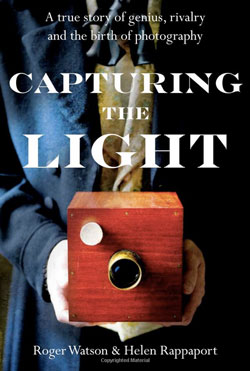Fascinating book review by the Wall Street Journal. Between smartphones, computers and ever-observant surveillance cameras, living in the modern world means leaving a contrail of images. Though now mundane, the snatching of a lifelike image from the flux of time once appeared miraculous. Capturing the Light by Roger Watson and Helen Rappaport tells the story of two men — a theatrical impresario and a gentleman scholar — separately inventing photography almost simultaneously.
The authors’ protagonists, Louis Daguerre and Henry Fox Talbot, make a fascinating study in contrast. Was Daguerre really the inventor of photography?
The work on the Daguerre process was taking place at the same time as that of Talbot’s work in England on the calotype process. Daguerre’s agent in England applied for a British patent a matter of days before France, having granted Daguerre a pension, declared his invention “free to the world.” Great Britain therefore became the only country where the payment of license fees was required to use the Daguerre process.
Talbot, on the other hand, claimed experiments beginning in the mid-30s, when the artist and showman Daguerre made his name creating theatrical dioramas in which lifelike scenes were presented on huge, carefully lighted sheets of silk before he turned to opto-chemical tinkering.

In England, the gentleman scholar Talbot hung fire after his first successes in 1935, seeking to improve his process — until Daguerre’s unexpected announcement jolted him into making his own work public. “Henry Talbot had, for some time, been well ahead of Louis Daguerre’s game,” the authors write. “But it was entirely his own fault that he had been caught well and truly napping.”
The ensuing patenting controversy and struggle for public recognition occupies much of Mr. Watson and Ms. Rappaport’s account. Though retiring by nature, Talbot found himself caught up in protracted legal battles to enforce his claims. Resented for trying to augment his own inherited wealth, Talbot tended to lose the goodwill of the public even while his expensive lawsuits failed to forestall those who wanted to use his process without paying him.
Naturally, these struggles bore the marks of French-British rivalry in the post-Napoleonic era. The magnanimity of the French donation contrasted neatly with the profit-marred British counter-initiative. Talbot’s contemporaries urged him to relax his proprietary claims lest they retard the development of photography in Britain. “The French were now working on improving the calotype,” the authors write — Talbot’s patents were widely flouted, being too expensive to enforce — “and Britain must not be left behind.” Talbot relented but still demanded royalties from commercial photographers.
Yet, as befits such a fundamental discovery, the story goes much further. Whatever their individual claims or merits, Daguerre and Talbot, not long after their initial inventions, ceased to be the main innovators. Daguerre retired on his pension but died only a decade after his discovery; Talbot lived long enough to see his process overtake Daguerre’s through its greater practicality.
Mr. Watson and Ms. Rappaport give considerable attention to the larger forces that swept photography from being a craze to becoming deeply embedded in everyday life. They underline the ways in which photographic technology surmounted its initial limitations, such as the need for long exposure times. Amplified by ensuing innovations, photography’s promise seemed almost limitless. Some wondered whether photography might be able to recover the image imprinted on the retina of a dying man, the last thing he saw, perhaps even the face of his murderer.
In particular, the authors note how photography insinuated itself into the realm of intimate feelings. The grieving Queen Victoria, for example, constructed an altar of photographs of her deceased husband, Prince Albert, as if his photographic image constituted his visible afterlife. In filling tables to overflowing with portraits, she was following the same inner impulse that continues to lead others to find human connection in private photographic shrines, now ever more portable on laptops and phones.
Mr. Watson and Ms. Rappaport do not question these emotional resonances too deeply, as fluently as they survey the omnipresent progress of photography. Their thoroughly enjoyable book has a curiously old-fashioned quality, almost as if it were itself a 19th century image, and a rather pleasant one: slightly sepia toned and affectionate, not much concerned with darker suggestions that the camera is capable of distorting reality rather than reproducing it faithfully.
You can order Capturing the Light from Amazon.


